[English] 日本語
 Yorodumi
Yorodumi- PDB-7lhi: Cryo-EM structure of E. coli P pilus tip assembly intermediate Pa... -
+ Open data
Open data
- Basic information
Basic information
| Entry | Database: PDB / ID: 7lhi | |||||||||
|---|---|---|---|---|---|---|---|---|---|---|
| Title | Cryo-EM structure of E. coli P pilus tip assembly intermediate PapC-PapD-PapK-PapF-PapG | |||||||||
 Components Components |
| |||||||||
 Keywords Keywords | CHAPERONE / Cryo-EM / Uropathogenic Escherichia coli / chaperone-usher / P pilus | |||||||||
| Function / homology |  Function and homology information Function and homology informationcell adhesion involved in single-species biofilm formation / pilus / : / cell wall organization / outer membrane-bounded periplasmic space / carbohydrate binding / cell adhesion / extracellular region Similarity search - Function | |||||||||
| Biological species |  | |||||||||
| Method | ELECTRON MICROSCOPY / single particle reconstruction / cryo EM / Resolution: 7.6 Å | |||||||||
 Authors Authors | Du, M. / Yuan, Z. / Werneburg, G. / Henderson, N. / Chauhan, H. / Kovach, A. / Zhao, G. / Johl, J. / Li, H. / Thanassi, D. | |||||||||
| Funding support |  United States, 2items United States, 2items
| |||||||||
 Citation Citation |  Journal: Nat Commun / Year: 2021 Journal: Nat Commun / Year: 2021Title: Processive dynamics of the usher assembly platform during uropathogenic Escherichia coli P pilus biogenesis. Authors: Minge Du / Zuanning Yuan / Glenn T Werneburg / Nadine S Henderson / Hemil Chauhan / Amanda Kovach / Gongpu Zhao / Jessica Johl / Huilin Li / David G Thanassi /  Abstract: Uropathogenic Escherichia coli assemble surface structures termed pili or fimbriae to initiate infection of the urinary tract. P pili facilitate bacterial colonization of the kidney and ...Uropathogenic Escherichia coli assemble surface structures termed pili or fimbriae to initiate infection of the urinary tract. P pili facilitate bacterial colonization of the kidney and pyelonephritis. P pili are assembled through the conserved chaperone-usher pathway. Much of the structural and functional understanding of the chaperone-usher pathway has been gained through investigations of type 1 pili, which promote binding to the bladder and cystitis. In contrast, the structural basis for P pilus biogenesis at the usher has remained elusive. This is in part due to the flexible and variable-length P pilus tip fiber, creating structural heterogeneity, and difficulties isolating stable P pilus assembly intermediates. Here, we circumvent these hindrances and determine cryo-electron microscopy structures of the activated PapC usher in the process of secreting two- and three-subunit P pilus assembly intermediates, revealing processive steps in P pilus biogenesis and capturing new conformational dynamics of the usher assembly machine. | |||||||||
| History |
|
- Structure visualization
Structure visualization
| Movie |
 Movie viewer Movie viewer |
|---|---|
| Structure viewer | Molecule:  Molmil Molmil Jmol/JSmol Jmol/JSmol |
- Downloads & links
Downloads & links
- Download
Download
| PDBx/mmCIF format |  7lhi.cif.gz 7lhi.cif.gz | 290 KB | Display |  PDBx/mmCIF format PDBx/mmCIF format |
|---|---|---|---|---|
| PDB format |  pdb7lhi.ent.gz pdb7lhi.ent.gz | 225.2 KB | Display |  PDB format PDB format |
| PDBx/mmJSON format |  7lhi.json.gz 7lhi.json.gz | Tree view |  PDBx/mmJSON format PDBx/mmJSON format | |
| Others |  Other downloads Other downloads |
-Validation report
| Summary document |  7lhi_validation.pdf.gz 7lhi_validation.pdf.gz | 735 KB | Display |  wwPDB validaton report wwPDB validaton report |
|---|---|---|---|---|
| Full document |  7lhi_full_validation.pdf.gz 7lhi_full_validation.pdf.gz | 746.8 KB | Display | |
| Data in XML |  7lhi_validation.xml.gz 7lhi_validation.xml.gz | 44.3 KB | Display | |
| Data in CIF |  7lhi_validation.cif.gz 7lhi_validation.cif.gz | 67.3 KB | Display | |
| Arichive directory |  https://data.pdbj.org/pub/pdb/validation_reports/lh/7lhi https://data.pdbj.org/pub/pdb/validation_reports/lh/7lhi ftp://data.pdbj.org/pub/pdb/validation_reports/lh/7lhi ftp://data.pdbj.org/pub/pdb/validation_reports/lh/7lhi | HTTPS FTP |
-Related structure data
| Related structure data |  23341MC  7lhgC  7lhhC M: map data used to model this data C: citing same article ( |
|---|---|
| Similar structure data |
- Links
Links
- Assembly
Assembly
| Deposited unit | 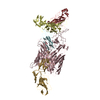
|
|---|---|
| 1 |
|
- Components
Components
| #1: Protein | Mass: 88746.297 Da / Num. of mol.: 1 Source method: isolated from a genetically manipulated source Source: (gene. exp.)   |
|---|---|
| #2: Protein | Mass: 37620.570 Da / Num. of mol.: 1 Source method: isolated from a genetically manipulated source Source: (gene. exp.)   |
| #3: Protein | Mass: 17807.197 Da / Num. of mol.: 1 Source method: isolated from a genetically manipulated source Source: (gene. exp.)   |
| #4: Protein | Mass: 24589.895 Da / Num. of mol.: 1 Source method: isolated from a genetically manipulated source Source: (gene. exp.)   |
| #5: Protein | Mass: 18895.492 Da / Num. of mol.: 1 Source method: isolated from a genetically manipulated source Source: (gene. exp.)   |
-Experimental details
-Experiment
| Experiment | Method: ELECTRON MICROSCOPY |
|---|---|
| EM experiment | Aggregation state: PARTICLE / 3D reconstruction method: single particle reconstruction |
- Sample preparation
Sample preparation
| Component | Name: PapCDKFG / Type: COMPLEX / Entity ID: all / Source: RECOMBINANT |
|---|---|
| Molecular weight | Experimental value: NO |
| Source (natural) | Organism:  |
| Source (recombinant) | Organism:  |
| Buffer solution | pH: 7.5 |
| Specimen | Embedding applied: NO / Shadowing applied: NO / Staining applied: NO / Vitrification applied: YES |
| Vitrification | Cryogen name: ETHANE |
- Electron microscopy imaging
Electron microscopy imaging
| Experimental equipment |  Model: Titan Krios / Image courtesy: FEI Company |
|---|---|
| Microscopy | Model: FEI TITAN KRIOS |
| Electron gun | Electron source:  FIELD EMISSION GUN / Accelerating voltage: 300 kV / Illumination mode: FLOOD BEAM FIELD EMISSION GUN / Accelerating voltage: 300 kV / Illumination mode: FLOOD BEAM |
| Electron lens | Mode: BRIGHT FIELD |
| Image recording | Electron dose: 50 e/Å2 / Film or detector model: GATAN K2 SUMMIT (4k x 4k) |
- Processing
Processing
| CTF correction | Type: PHASE FLIPPING AND AMPLITUDE CORRECTION |
|---|---|
| 3D reconstruction | Resolution: 7.6 Å / Resolution method: FSC 0.143 CUT-OFF / Num. of particles: 119682 / Symmetry type: POINT |
| Atomic model building | Protocol: RIGID BODY FIT |
 Movie
Movie Controller
Controller




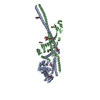
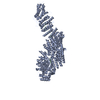
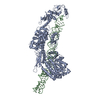
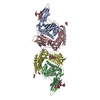

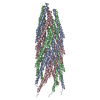

 PDBj
PDBj
